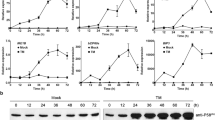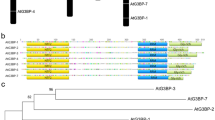Abstract
The unfolded protein response (UPR), a highly conserved cellular defense pathway, is activated by endoplasmic reticulum (ER) stress. In Arabidopsis, the transcription factor AtbZIP28 mediates ER stress responses induced by tunicamycin. Here, we identified NbbZIP28 in Nicotiana benthamiana. Sequence analyses showed that the NbbZIP28 encodes a protein of 812 amino acids with a putative transmembrane domain (TMD) near its C terminus next to a basic leucine zipper domain. In localization analyses, NbbZIP28 was located in the ER, and NbbZIP28∆C, a truncated form of NbbZIP28 that lacked the region from the TMD to the carboxy terminus, localized in the nucleus. The transcript levels of NbbZIP28 were significantly up-regulated at 48 h post inoculation with Cucumber mosaic virus and Tobacco mosaic virus. NbbZIP28-silenced N. benthamiana plants showed no significant phenotypic change, but viruses were able to accumulate to higher levels in the silenced plants than in control plants. The NbbZIP28-silenced plants showed lower transcript levels of UPR genes including BiP and NF-YC2 at the early stage of virus infection, although the transcript levels recovered or even increased at a later stage, indicating that NbbZIP28 may be a key regulator, among others, of UPR,. In summary, the ER-localized transcription factor NbbZIP28 may play a role in the defense response against viruses by promoting the UPR pathway activation in N. benthamiana.






Similar content being viewed by others
References
Artico, S., Nardeli, S. M., Brilhante, O., Grossi-de-Sa, M. F., & Alves-Ferreira, M. (2010). Identification and evaluation of new reference genes in Gossypium hirsutum for accurate normalization of real-time quantitative RT-PCR data. BMC Plant Biology, 21, 10–49.
Gao, H., Brandizzi, F., Benning, C., & Larkin, R. M. (2008). A membrane-tethered transcription factor defines a branch of the heat stress response in Arabidopsis thaliana. Proceedings of the National Academy of Sciences of the United States of America, 105, 16398–16403.
Haseloff, J., Siemering, K. R., Prasher, D. C., & Hodge, S. (1997). Removal of a cryptic intron and subcellular localization of green fluorescent protein are required to mark transgenic Arabidopsis. Proceedings of the National Academy of Sciences of the United States of America, 94, 2122–2127.
Hayashi, S., Wakasa, Y., Takahashi, H., Kawakatsu, T., & Takaiwa, F. (2011). Signal transduction by IRE1-mediated splicing of bZIP50 and other stress sensors in the endoplasmic reticulum stress response of rice. The Plant Journal, 69, 946–956.
Haze, K., Yoshida, H., Yanagi, H., Yura, T., & Mori, K. (1999). Mammalian transcription factor ATF6 is synthesized as a transmembrane protein and activated by proteolysis in response to endoplasmic reticulum stress. Molecular Biology of the Cell, 10, 3787–3799.
Hetz, C. (2012). The unfolded protein response: Controlling cell fate decisions under ER stress and beyond. Nat Rev Mol Cell Bio, 13, 89–102.
Iwata, Y., & Koizumi, N. (2005). An Arabidopsis transcription factor, AtbZIP60, regulates the endoplasmic reticulum stress response in a manner unique to plants. Proceedings of the National Academy of Sciences of the United States of America, 102, 5280–5285.
Jheng, J. R., Ho, J. Y., & Horng, J. T. (2014). ER stress, autophagy, and RNA viruses. Frontiers in Microbiology, 5, 1–13.
Lilly, S. T., Drummond, R. S., Pearson, M. N., & MacDiarmid, R. M. (2011). Identification and validation of reference genes for normalization of transcripts from virus-infected Arabidopsis thaliana. Molecular Plant-Microbe Interactions, 24, 294–304.
Liu, J. X., & Howell, S. H. (2010). bZIP28 and NF-Y transcription factors are activated by ER stress and assemble into a transcriptional complex to regulate stress response genes in Arabidopsis. Plant Cell, 22, 782–796.
Liu, Y., Schiff, M., Marathe, R., & Dinesh-Kumar, S. P. (2002). Tobacco Rar1, EDS1 and NPR1/NIM1 like genes are required for N-mediated resistance to tobacco mosaic virus. Plant Journal, 30, 415–429.
Liu, Y. L., Schiff, M., Czymmek, K., Tallòczy, Z., Levine, B., & Dinesh-Kumar, S. P. (2005). Autophagy regulates programmed cell death during the plant innate immune response. Cell, 121, 567–577.
Liu, J. X., Srivastava, R., Che, P., & Howell, S. H. (2007a). An ER stress response in Arabidopsis is mediated by proteolytic processing and nuclear relocation of a membrane-associated transcription factor AtbZIP28. Plant Cell, 19, 4111–4119.
Liu, J. X., Srivastava, R., Che, P., & Howell, S. H. (2007b). Salt stress responses in Arabidopsis utilize a signal transduction pathway related to ER stress signaling. The Plant Journal, 51, 897–909.
Liu, D., Shi, L., Han, C., Yu, J., Li, D., & Zhang, Y. (2012). Validation of reference genes for gene expression studies in virus-infected Nicotiana benthamiana using quantitative real-time PCR. PloS One, 7, e46451.
Lu, D., & Christopher, D. A. (2008). Endooplasmic reticulum stress activates the expression of a subgroup of protein disulfide isomerase genes and AtbZIP60 modulates the response in Arabidopsis thaliana. Molecular Genetics and Genomics, 280, 199–210.
Lu, S. J., Yang, Z. T., Sun, L., Sun, L., Song, Z. T., & Liu, J. X. (2012). Conservation of IRE1-regulated bZIP74 mRNA unconventional splicing in rice (Oryza sativa L.) involved in ER stress responses. Molecular Plant, 5, 504–514.
Lu, Y., Yin, M., Wang, X., Chen, B., Yang, X., & Peng, J. (2016). The unfolded protein response and programmed cell death are induced by expression of garlic virus X p11 in Nicotiana benthamiana. The Journal of General Virology, 97, 1462–1468.
Sun, Z. T., Yang, D., Xie, L., Sun, L. Y., Zhang, S. L., Zhu, Q. S., et al. (2013). Rice black-streaked dwarf virus P10 induces membranous structures at the ER and elicits the unfolded protein response in Nicotiana benthamiana. Virology, 447, 131–139.
Sun, L. (2013a). Functional characterization of a transcription factor NAC103 in the ER stress response in Arabidopsis [D]. FuDan University.
Sun, L., Yang, Z. T., Song, Z. T., Wang, M. J., Sun, L., Lu, S. J., et al. (2013b). The plant-specific transcription factor gene NAC103 is induced by bZIP60 through a new cis-regulatory element to modulate the unfolded protein response in Arabidopsis. The Plant Journal, 76, 274–286.
Sun, L., Lu, S. J., Zhang, S. S., Zhou, S. F., Sun, L., & Liu, J. X. (2013c). The lumen-facing domain is important for the biological function and organelle-to-organelle movement of bZIP28 during ER stress in Arabidopsis. Molecular Plant, 6, 1605–1615.
Sun, L., Zhang, S. S., Lu, S. J., & Liu, J. X. (2015). Site-1 protease cleavage site is important for the ER stress-induced activation of membrane-associated transcription factor bZIP28 in Arabidopsis. Science China. Life Sciences, 53, 270–275.
Srivastava, R., Chen, Y., Deng, Y., Brandizzi, F., & Howell, S. H. (2012). Elements proximal to and within the transmembrane domain mediate the organelle-to-organelle movement of bZIP28 under ER stress conditions. The Plant Journal, 70, 1033–1042.
Srivastava, R., Deng, Y., Shah, S., Rao, A. G., & Howell, S. H. (2013). Binding protein is a master regulator of the endoplasmic reticulum stress sensor/transducer bZIP28 in Arabidopsis. The Plant Cell, 25, 1416–1429.
Srivastava, R., Deng, Y., & Howell, S. H. (2014). Stress sensing in plants by an ER stress sensor/transducer bZIP28. Plant Cell Biology, 5, 1–6.
Tateda, C., Ozaki, R., Onodera, Y., Takahashi, Y., Yamaguchi, K., Berberich, T., et al. (2008). NtbZIP60, an endoplasmic reticulum-localized transcription factor, plays a role in the defense response against bacterial pathogens in Nicotiana tabacum. Journal of Plant Research, 121, 603–611.
Takahashi, H., Kawakatsu, T., Wakasa, Y., Hayashi, S., & Takaiwa, F. (2011). A rice transmembrane bZIP transcription factor, OsbZIP39, regulates the endoplasmic reticulum stress response. Plant & Cell Physiology, 53, 144–153.
Wang, B., Zheng, J., Liu, Y. J., Wang, J. H., & Wang, G. Y. (2012). Cloning and characterization of the stress-induced bZIP gene ZmbZIP60 from maize. Molecular Biology Reports, 39, 6319–6327.
Wang, Y., Abd-Alla, A. M., Bossin, H., & Li, Y. (2013). Bergoin M. Analysis of the transcription strategy of the Junonia coenia densovirus (JcDNV) genome. Virus Research, 174, 101–107.
Yang, Z. T., Wang, M. J., Sun, L., Lu, S. J., Bi, D. L., Sun, L., et al. (2014). The membrane-associated transcription factor NAC089 controls ER-stress-induced programmed cell death in plants. PLoS Genetics, 10, 1–15.
Ye, C. M., Dickman, M. B., Whitham, S. A., Payton, M., & Verchot, J. (2011). The unfolded protein response is triggered by a plant viral movement protein. Plant Physiology, 156, 741–755.
Ye, C. M., Chen, S. R., Payton, M., Dickman, M. B., & Verchot, J. (2013). TGBp3 triggers the unfolded protein response and SKP1-dependent programmed cell death. Molecular Plant Pathology, 14, 241–255.
Zhang, L. R., & Wang, A. M. (2012). Virus-induced ER stress and the unfolded protein response. Frontiers in Plant Science, 3, 293.
Zhang, L., Chen, H., Brandizzi, F., Verchot, J., & Wang, A. (2015). The UPR branch IRE1-bZIP60 in plants plays an essential role in viral infection and is complementary to the only UPR pathway in yeast. PLoS Genetics, 11, e1005164.
Zeng, Y. L., Chung, K. P., Li, B. Y., Lai, C. M., Lam, S. K., Wang, X. F., et al. (2015). Unique COPII component AtSar1a/AtSec23a pair is required for the distinct function of protein ER export in Arabidopsis thaliana. Proceedings of the National Academy of Sciences of the United States of America, 112, 14360–14365.
Zhu, F., Xi, D. H., Yuan, S., Xu, F., Zhang, D. W., & Lin, H. H. (2014). Salicylic acid and jasmonic acid are essential for systemic resistance against tobacco mosaic virus in Nicotiana benthamiana. Mol Plant Microbe In, 27, 567–577.
Acknowledgements
This study was funded by the Agricultural Science and Technology Innovation Program (ASTIP-TRIC04, HYHY2016YL02, 1610232016004).
Author information
Authors and Affiliations
Corresponding authors
Electronic supplementary material
ESM 1
Virus-induced gene silencing (VIGS) of NbbZIP28 in Nicotiana benthamiana. (a) Appearance of control and NbbZIP28-silenced N. benthamiana plants. (b) qRT-PCR analysis of NbbZIP28 transcript levels in NbbZIP28-silenced plants at 15 days post agro-infiltration. Actin was used as the internal reference gene. (c) qRT-PCR analysis of TRV transcript levels in NbbZIP28-silenced plants and TRV:00 plants. The values represent the endogenous control (PP2A or L23) and calibrator (TRV:00) subtracted from the target sample value to provide the 2 − ∆∆CT with three independent replications. Significant differences (P < 0.05) are denoted by different lowercase letters. (JPEG 469 kb)
ESM 2
qRT-PCR analysis of unfolded protein response (UPR) gene BiP and NF-YC2 transcript levels in NbbZIP28-silenced or TRV:00 plants infected with Cucumber mosaic virus (CMV), compared with 0 h plants respectively (a), and the relative expression of BiP and NF-YC2 in NbbZIP28-silenced plants compared to the TRV:00 control (b). PP2A was used as the internal reference gene. “0 h” indicates plants inoculated with phosphate buffered saline (PBS). (JPEG 419 kb)
ESM 3
qRT-PCR analysis of unfolded protein response gene transcript levels in NbbZIP28-silenced plants compared to the TRV:00 control in response to infection by Cucumber mosaic virus (a) or Tobacco mosaic virus (b). The values represent the endogenous control (PP2A) and calibrator (a constant quantity of TRV:00 at different time points) subtracted from the target sample value to provide the 2 − ∆∆CT with three independent replications. Significant differences (P < 0.05) are denoted by different lowercase letters. (JPEG 567 kb)
ESM 4
qRT-PCR analysis of BiP transcript levels in NbbZIP28-silenced plants compared to the TRV:00 control in response to infection by Tobacco mosaic virus. L23 was used as the internal reference gene. Significant differences (P < 0.05) are denoted by different lowercase letters. (JPEG 116 kb)
Rights and permissions
About this article
Cite this article
Shen, L., Li, F., Dong, W. et al. Nicotiana benthamiana NbbZIP28, a possible regulator of unfolded protein response, plays a negative role in viral infection. Eur J Plant Pathol 149, 831–843 (2017). https://doi.org/10.1007/s10658-017-1231-8
Accepted:
Published:
Issue Date:
DOI: https://doi.org/10.1007/s10658-017-1231-8




